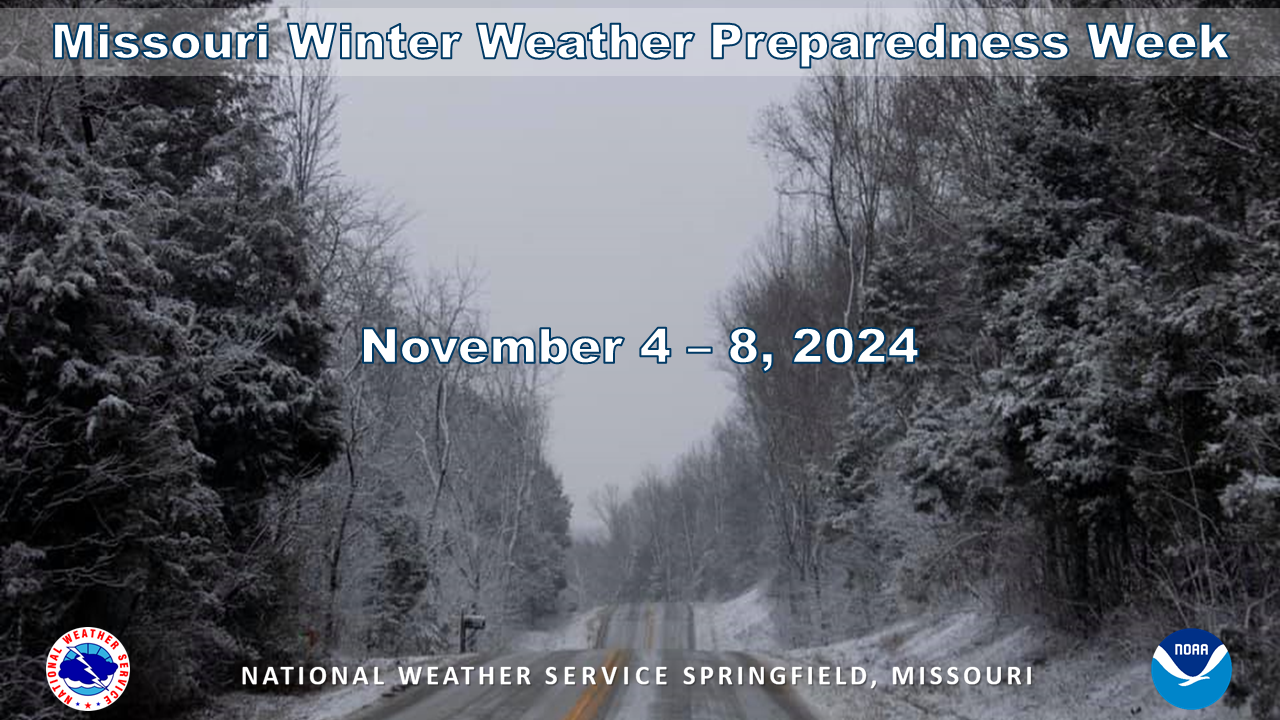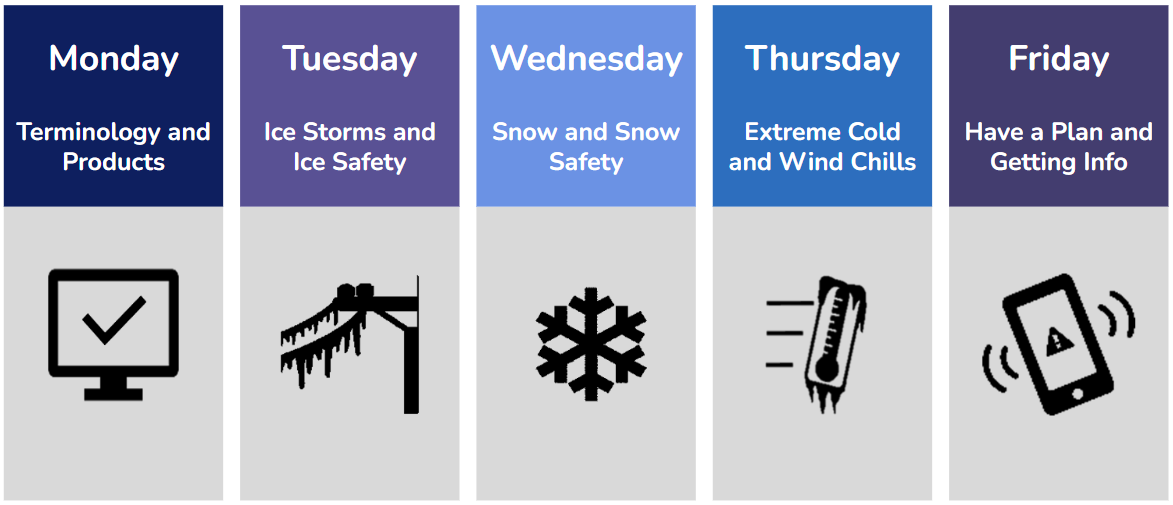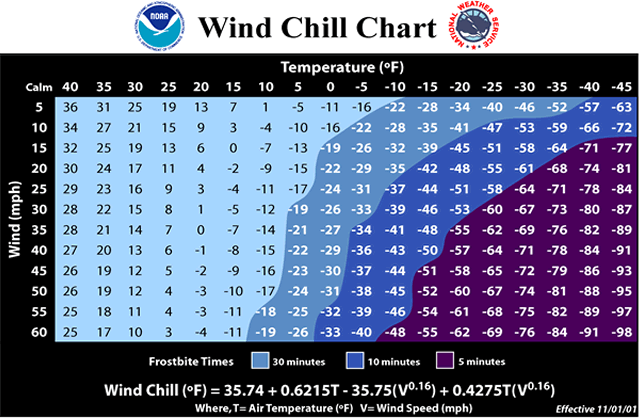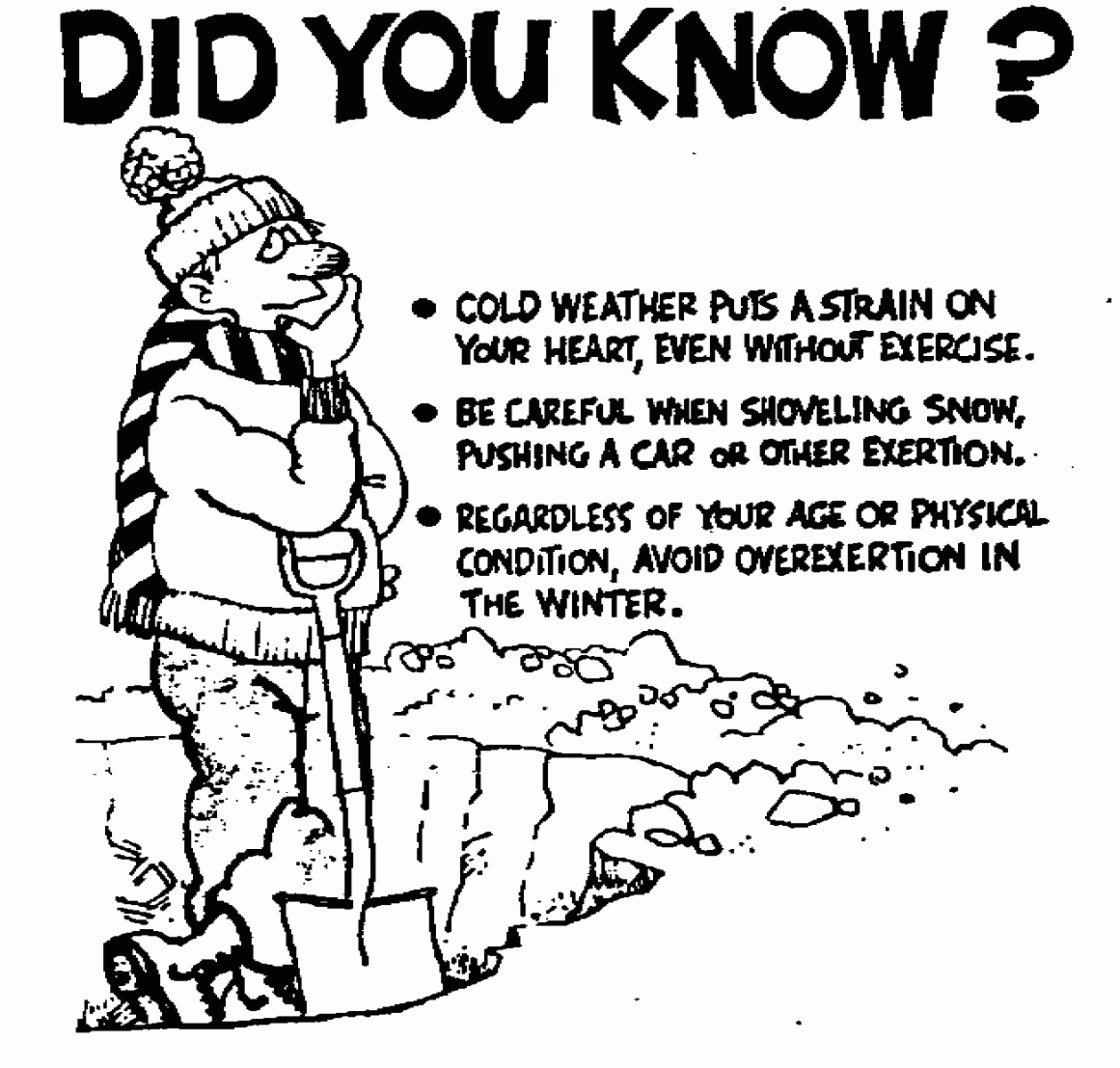

The National Weather Service (NWS) along with the Missouri Department of Public Safety (DPS), Missouri State Emergency Management Agency (SEMA), the Department of Health and Senior Services (DHSS), the Missouri Highway Patrol (MHP), and the State Fire Marshal, has designated November 4-8, 2024 as Winter Weather Preparedness Week for the state of Missouri. Winter storms and cold temperatures can be extremely dangerous. We urge people to use this week to review the hazards and safety rules of winter weather so they are prepared for the upcoming winter season.
Winter Precipitation

Extreme cold temperatures are a big danger during winter months in Missouri. Prolonged exposure to the cold can cause frostbite, hypothermia, or in extreme cases death. In fact, excessive cold is one of the leading weather-related causes of death across the country. Infants and the elderly are most susceptible to extreme cold. Freezing temperatures also cause damage to crops and property.
Cold Related Deaths in Missouri*
* Source: Missouri Department of Health and Senior Services (DHSS). For more information on cold weather safety, statistics, etc, visit the DHSS website. DHSS Hypothermia Web Site.
Since the DHSS surveillance program began in Missouri during the winter of 1979-1980, there have been 631 deaths in which hypothermia was a factor.
Frostbite occurs when the skin becomes cold enough to actually freeze. A loss of feeling and a white or pale appearance in extremities, such as fingers, toes, ear lobes, or the nose are symptoms of frostbite.
Hypothermia (Low Body Temperature) can occur during long periods of exposure when the body temperature drops below 95 degrees F. A person will become disoriented, confused, and shiver uncontrollably, eventually leading to drowsiness and apparent exhaustion. In severe cases, death is possible.
Wind Chill
Wind Chill is the term used to describe the rate of heat loss on the human body resulting from the combined effect of low temperature and wind. As winds increase, heat is carried away from the body at a faster rate, driving down both the skin temperature and eventually internal body temperature. While exposure to low wind chills can be life threatening to both humans and animals alike, the only effect that wind chill has on inanimate objects, such as vehicles, is that is shortens the time it takes the object to cool to the actual air temperature (it cannot cool the object below that temperature). For example, water freezes at 32 degrees F, regardless of what the wind chill temperature is.
The current wind chill temperature index (WCT) formula was developed during 2000 -2001 and implemented for the winter of 2001-2002. A Joint Action Group for temperature Indices (JAG/TI) consisting of the NWS, Meteorologic Services of Canada (MSC), the academic research community (Indiana University-Purdue University in Indianapolis (IUPUI), University of Delaware, and University of Missouri), and the International Society of Biometeorology, developed the formula. The JAG/TI formula made use of the advances in science, technology, and computer modeling to provide a more accurate, understandable, and useful formula for calculating the dangers from winter winds and freezing temperatures. In addition, clinical trials were conducted and the results of those trials have been used to verify and improve the accuracy of the new formula.
Standardization of the WCT Index among the meteorological community is important, so that an accurate and consistent measure is provided and public safety is ensured. Some of the items incorporated into the WCT include:
incorporated modern heat transfer theory (heat loss from the body to its surroundings,
during cold and breezy/windy days)
lowered the calm wind threshold to 3 mph
used a consistent standard for skin tissue resistance; and
assumed the worst case scenario for solar radiation (clear night sky).

|
City |
Temperature |
Date |
| Springfield |
-29 |
February 12, 1899 |
| Joplin | -21 | February 13, 1905 |
| West Plains |
-21 |
February 2, 1951 |
| Vichy-Rolla |
-29 |
February 12, 1899 |
| Warsaw | -40 | February 13, 1905 |
School Safety
Children can be especially susceptible to the dangers associated with winter weather. Their youthful enthusiasm often takes over when common sense should prevail.
School administrators and principals need to be sensitive to the dangers winter weather can pose to children and be prepared. Winter weather procedures and practices need to be established before the onset of winter cold. The following items should be considered when formulating a winter weather safety plan:
Generator Safety
Severe winter storms can cut off your supply of electricity and other winter fuels. It is important to have an alternative heat source available. However, be extremely careful in using fireplaces or wood stoves. Make sure they are properly ventilated to avoid the build up of carbon monoxide, an odorless, colorless, and deadly gas. Do not use charcoal indoors as it gives off large amounts of carbon monoxide. Have your furnace checked before the weather gets cold to make sure it is in good working order. Using alternative heat sources can also be a fire danger. Be very careful because if conditions are bad, the fire department may not be able to get to you. Make sure your smoke alarms are working and have fresh batteries. It is also a good idea to have carbon monoxide alarms in your home adjacent to sleeping areas.
Portable electric generators like the one pictured above have become very popular. They can be an excellent piece of equipment to have should you lose electric power for an extended period of time. However they must be used safely and properly. A small generator can usually only run one major appliance at a time. It is also very important to place the generator OUTSIDE! The exhaust from the engine emits deadly carbon monoxide gas. Make sure you read the manual carefully and follow all the recommended safety precautions.
State Fire Marshal Safety Tips
Acting State Fire Marshal Greg Carrell would like to caution Missourians again this year to the potential fire and carbon monoxide hazards winter weather situations create. “Unfortunately many Missourians turn to using devices not designed for use as a supplemental heat source thereby placing themselves and others in life threatening situations,” Carrell said. “It is important to maintain fire safety awareness throughout the winter.”
Too many preventable fires occur year-round, especially during the winter months. During this time Missourians should examine heating methods, practice fire escape plans and check smoke detectors. Fires related to home heating are primarily responsible for the increased number of fires during the winter.
Acting State Fire Marshal Carrell stresses the importance of ensuring a home has working smoke and carbon monoxide alarms and testing them monthly to ensure they’re in working order. The advance warning these alarms provide can prevent tragedy by giving families enough time to get out of their house alive.
All gasoline and diesel generators create carbon monoxide, a colorless, odorless, tasteless gas that inhibits the body’s ability to absorb oxygen, a condition that can cause serious health problems, and even death, within a matter of minutes. The first symptoms of carbon monoxide poisoning usually include headache, lightheadedness, dizziness and unexplained sleepiness.
Tips for winter storm fire safety:
• Use battery operated lanterns or flashlights instead of candles and oil lamps during power outages.
• Keep generators outside of occupied buildings and never run a generator in an attached garage.
• Never use fossil fueled (propane, kerosene or heating oil) space heaters in an enclosed room; these heaters require a well ventilated area to prevent the accumulation of carbon monoxide.
• Keep chimneys, fireplaces and flues clean and never use a liquid fuel or cardboard to start a fire in a woodstove or fireplace.
• Do not use extension cords to power electric space heaters or use any electric heater that has the cord frayed, repaired or improperly replaced.
• Vehicle exhaust fumes contain large quantities of carbon monoxide. Never run a vehicle in a garage. If you are stuck in a vehicle, make sure the exhaust pipe is clear of snow, ice or debris and only run the engine for short periods to maintain warmth in the vehicle.
For more information about planning for a winter emergency, you should contact your local emergency officials. The Missouri Department of Health and Senior Services (www.dhss.mo.gov), offers the Ready-in- 3 Emergency Plan Guide. (http://www.dhss.mo.gov/Ready_in_3/)
For information concerning winter fire safety, contact your local fire department, the Missouri State Fire Marshal’s Office at (573)751-2930, or on the Internet at, http://www.dfs.dps.mo.gov/.
Winter Weather Products and Criteria
Note: The criteria differs for other areas of Missouri that are covered by other NWS offices. Consult the office responsible for your area.
Watch - A watch is used when the risk of hazardous winter weather has increased significantly, there is a strong possibility it will reach warning criteria, and falls in the 12 to 48 hour portion of the forecast.
Warning - The following warnings are issued when an event is occurring, is imminent, or has a high probability of occurrence. Warnings are issued for events that can be life threatening. The following warnings can be issued.
Blizzard Warning: Sustained wind or frequent gusts greater than or equal to 35 mph accompanied by falling and/ or blowing snow, frequently reducing visibility to less than 1/4 mile for three hours or more.
Ice Storm Warning: Ice accumulation of 1/4 inch or more.
Winter Storm Warning: Issued for snow events of 5 inches or more, sleet accumulations of 1/2 inch or more, or a combination of winter precipitation which will create life threatening conditions.
Extreme Cold Warning: Ambient temperature or wind chill temperatures around -15 to -20 or below.
Advisory - The following advisories will be issued when an event is occurring, is imminent, or has a high probability of occurrence. These are issued for lesser events that while presenting an inconvenience, do not pose an immediate threat of death, injury, or significant property damage.
Winter Weather Advisory: Issued for lesser snowfall amounts. Depending on when the snow will fall and the temperatures an advisory could be issued for anywhere from 1 to 5 inches of snowfall. An advisory will be issued for sleet accumulations of less than 1/2 inch, or an advisory can be issued when a combination of winter precipitation which will produce hazardous conditions. .
Cold Weather Advisory: Ambient temperature or wind chill temperatures around -5 to -10 or below.

Severe winter weather can strand you in your own home. It is a good idea to keep some extra supplies around during the winter season. Items you may want to have include non-perishable food, medical supplies, batteries, and emergency heating supplies.

Working in cold weather puts a tremendous strain on the body, even for people in good shape. Take frequent breaks and don't overexert yourself. Make sure you dress properly for the conditions. Wear several layers of lightweight clothing. Air is trapped between the layers to help keep the body warm. Protect the extremities, such as the hands, feet and ears as they are the most susceptible to frostbite. Wear a hat as a large percentage of the body's heat is lost through the top of the head.


Travel in winter can be extremely dangerous. The best thing to do is cancel any travel if winter weather will occur. However if you must travel, make sure you plan ahead. Make sure other people know your travel plans and know how to contact you. Travel in convoy with other vehicles if possible. Keep a survival kit in you vehicle. This kit should include items which include non-perishable food such as can goods or candy bars, extra clothes and blankets, a battery powered radio, a shovel, and sand. If stranded, the best thing to do in to stay in the vehicle. Tie a bright colored cloth to the antenna so rescuers can find you. Run the engine occasionally for heat making sure to keep the exhaust pipe clear. Open windows occasionally for fresh air.